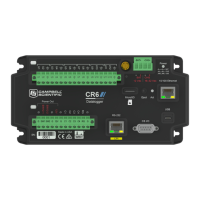2.4.3.2 RS-232, RS-485, TTL, and LVTTL ports
RS-232, RS-485, TTL, and LVTTL communications are typically used for the following:
l Reading sensors with serial output
l Creating a multi-drop network
l Communications with other data loggers or devices over long cables
Configure C or U terminals as serial ports using Device Configuration Utility or by using the
SerialOpen() CRBasic instruction. C and U terminals are configured in pairs for TTL and
LVTTL communications, and C terminals are configured in pairs for RS-232 or half-duplex RS-485.
For full-duplex RS-485, all four C terminals are required. See also Communications protocols (p.
90).
NOTE:
RS-232 ports are not isolated.
2.4.3.3 SDM ports
SDM is a protocol proprietary to Campbell Scientific that supports several Campbell Scientific
digital sensor and communications input and output expansion peripherals and select smart
sensors. It uses a common bus and addresses each node. CRBasic SDM device and sensor
instructions configure terminals C1, C2, and C3 together to create an SDM port. Alternatively,
terminals U1, U2, and U3; U5, U6, and U7; or U9, U10, and U11 can be configured together to be
used as SDM ports by using the SDMBeginPort() instruction.
See also Communications specifications (p. 224).
2.4.4 CS I/O port
One nine-pin port, labeled CS I/O, is available for communicating with a computer through
Campbell Scientific communications interfaces, modems, and peripherals. Campbell Scientific
recommends keeping CS I/O cables short (maximum of a few feet). See also Communications
specifications (p. 224).
Table 2-7: CS I/O pinout
Pin
Number
Function
Input(I)
Output(O)
Description
1 5 VDC O 5 VDC: sources 5 VDC, used to power peripherals.
2 SG
Signal ground: provides a power return for pin 1 (5V), and
is used as a reference for voltage levels.
2. Wiring panel and terminal functions 14

